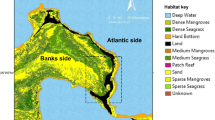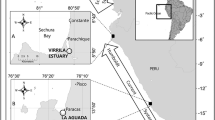Abstract
The Persimmon Eelpout (Eucryphycus californicus) is a relatively unknown, deep-sea fish inhabiting temperate marine waters on the west coast of North America. Using samples collected in the mid-1970s, the most recent targeted sampling for this species, we present basic life history attributes, and an analysis of the relationship between E. californicus and drift macrophyte habitat in the Monterey Canyon, California, USA. A diet analysis revealed that the fish consumes predominantly small crustaceans, especially amphipods and copepods, including species that associate with drift macrophyte habitat. Otoliths were analyzed to yield age estimates ranging from 0 to 6 years, and growth was modeled showing a maximum length of 203 mm for males and 271 mm for females. An analysis of the reproductive ecology of E. californicus showed that like many deep-sea fishes, females lay relatively few, large eggs. The species exhibits a protracted spawning period, and females spawn with only one functional ovary. Empirical information presented in this paper and anecdotal evidence shows that E. californicus likely relies on drift algae and seagrasses, a habitat subsidy exported to the deep-sea environment from adjacent kelp forest ecosystems, for shelter and to concentrate food resources. This example of a species dependent on an ecosystem subsidy adds to our knowledge regarding the effects of cross-ecosystem connectivity in the marine environment, and furthers our understanding of the ecology of the deep-sea macrofaunal assemblage in Monterey Bay.










Similar content being viewed by others
References
Anderson ME (1980) Aspects of the natural history of the midwater fish Lycodapus mandibularis (Zoarcidae) in Monterey Bay, California. Pac Sci 34(2):181–194
Anderson ME (1988) Eucryphycus, a new genus of California eelpout (Teleostei: Zoarcidae) based on Maynea californica Starks and Mann, 1911. Proc Calif Acad Sci 45(5):89–96
Bizzarro JJ, Robinson HJ, Rinewalt CS, Ebert DA (2007) Comparative feeding ecology of four sympatric skate species off central California, USA. Environ Biol Fish 80:197–220
Bosman AL, Hockey PAR (1986) Seabird guano as a determinant of rocky intertidal community structure. Mar Ecol Prog Ser 32:247–257
Breder CM, Rosen DE (1966) Modes of reproduction in fishes. Natural History Press, New York
Britton-Simmons K, Foley G, Okamoto D (2009) Spatial subsidy in the subtidal zone: utilization of drift algae by a deep subtidal sea urchin. Aquat Biol 5:233–243
Britton-Simmons KH, Rhoades AL, Pacunski RE, Galloway AWE, Lowe AT, Sosik EA, Dethier MN, Duggins DO (2012) Habitat and bathymetry influence the landscape-scale distribution and abundance of drift macrophytes and associated invertebrates. Limnol Oceanogr 57(1):176–184
Brown SC, Bizzarro JJ, Cailliet GM, Ebert DA (2011) Breaking with tradition: redefining measures for diet description with a case study of the Aleutian skate Bathyraja aleutica (Gilbert 1896). Environ Biol Fish 95(1):3–20
Cailliet GM, Lea RN (1977) Abundance of the rare Zoarcid, Maynea californica Gilbert, 1915, in the Monterey Canyon, Monterey Bay, California. Calif Fish Game 63(4):253–261
Duggins DO, Gomez-Buckley MC, Buckley RM, Lowe AT, Galloway AWE, Dethier MN (2016) Islands in the stream: kelp detritus as faunal magnets. Mar Biol 163(1):1–10
Duhamel G, Kock KH, Balguerias E, Hureau JC (1993) Reproduction in fish of the Weddell Sea. Polar Biol 13:193–200
Ferry L (1994) Natural history of two-line eelpouts (Bothrocara brunneum, family Zoarcidae). Thesis, Moss Landing Marine Laboratories
Ferry LA (1997) Food habits of the two-line eelpout (Bothracara brunneum: Zoarcidae) at two deep-sea sites in the eastern North Pacific. Deep Sea Res Part 1 Oceanogr Res Papers 44(3):521–531
Ferry LA, Cailliet GM (1996) Sample size sufficiency and data analysis: Are we characterizing and comparing diet properly? In: MacKinlay D, Shearer K (eds) Feeding ecology and nutrition in fish: proceedings of the symposium on the feeding ecology and nutrition in fish. Int Cong Biol Fishes, San Francisco, pp 71–81
Ferry-Graham LA, Drazen JC, Franklin V, Ferry-Graham ALA, Drazen JC, Franklin V (2007) Laboratory observations of reproduction in the deep-water Zoarcids Lycodes cortezianus and Lycodapus mandibularis (Teleostei: Zoarcidae). Pac Sci 61(1):129–139
Froese BR (2006) Cube law, condition factor and weight – length relationships: history, meta-analysis and recommendations. J Appl Ichthyol 22:241–253
Gosztonyi AE (1977) Results of the research cruises of FRV Walther Herwig to South America Revision of the South American Zoarcidae (Osteichthyes, Blennioidei) with the description of three new genera and five new species. Arch Fisch Wiss. 27(3):191–249
Harrold C, Light K, Lisin S (1998) Organic enrichment of submarine-canyon and continental-shelf benthic communities by macroalgal drift imported from nearshore kelp forests. Limnol Oceanogr 43(4):669–678
Havermans C, Smetacek V (2018) Bottom-up and top-down triggers of diversification: A new look at the evolutionary ecology of scavenging amphipods in the deep sea. Prog Oceanogr 164:37–51
Heck KL, Carruthers TJB, Duarte CM, Hughes AR, Kendrick G, Orth RJ, Williams SW (2008) Trophic transfers from seagrass meadows subsidize diverse marine and terrestrial consumers. Ecosyst 11(7):1198–1210
Higgs ND, Gates AR, Jones DOB (2014) Fish food in the deep sea: revisiting the role of large food-falls. PLOS One 9(5)
Hildebrandt N, Bergmann M, Knust R (2011) Longevity and growth efficiency of two deep-dwelling Arctic zoarcids and comparison with eight other zoarcid species from different climatic regions. Polar Biol 34:1523–1533
Josselyn MN, Cailliet GM, Niesena TM, Cowen R, Hurley AC, Connor J, Hawes S (1983) Composition, export and faunal utilization of drift vegetation in the Salt River Submarine Canyon. Estuar Coast Shelf Sci 17:447–465
Keats DW, South GR, Steele DH (1985) Reproduction and egg guarding by Atlantic wolffish (Anarhichas lupus: Anarhichidae) and ocean pout (Macrozoarces americanus: Zoarcidae) in Newfoundland waters. Can J Zool 63:2565–2568
Kendall AW, Jennings CD, Beasley TM, Carpenter R, Somayajulu BLK (1983) Discovery of a cluster of unhatched fish eggs of a zoarcid buried 10 to 12 cm deep in continental slope sediments off Washington State, USA. Mar Biol 75:193–199
Kliever RG (1976) Natural history of Maynea california (Pisces: Zoarcidae) in a drift seaweed habitat in the Monterey submarine canyon, Monterey Bay, California. Thesis, Moss Landing Marine Laboratories, San Jose State University
Levin LA, Etter RJ, Rex MA, Gooday AJ, Smith CR, Pineda J, Stuart CT, Hessler RR, Pawson D (2001) Environmental influences on regional deep-sea species diversity. Ann Rev. Ecol Syst 32(2001):51–93
Lewis TL, Mews M, Jelinski DE, Zimmer M (2007) Detrital subsidy to the supratidal zone provides feeding habitat for intertidal crabs. Estuar Coasts 30(3):451–458
Liebowitz DM, Nielsen KJ, Dugan JE, Morgan SG, Malone DP, Largier JL, Hubbard DM, Carr MH (2016) Ecosystem connectivity and trophic subsidies of sandy beaches. Ecosphere 7(10):1–19
Marczak LB, Thompson RM, Richardson JS (2007) Meta-analysis: Trophic level, habitat, and productivity shape the food web effects of resource subsidies. Ecol 88(1):140–148
Marshall NB (1953) Egg size in Arctic, Antarctic and deep-sea fishes. Evol 7(4):328–341
McAllister DE, Anderson EM, Hunter JG (1981) Deep-water eelpouts, Zoarcidae, from Arctic Canada and Alaska. Can J Fish Aquat Sci 38:821–839
Mead GW, Bertelsen E, Cohen DM (1964) Reproduction among deep-sea fishes. Deep-Sea Res 11:569–596
Miller RJ, Reed DC, Brzezinski MA (2011) Partitioning of primary production among giant kelp (Macrocystis pyrifera), understory macroalgae, and phytoplankton on a temperate reef. Limnol Oceanogr 56(1):119–132
Okey TA (2003) Macrobenthic colonist guilds and renegades in Monterey Canyon (USA) drift algae: partitioning multidimensions. Ecol Monogr 73(3):415–440
Oksanen JA, Blanchet G, Friendly M, Kindt R, Legendre P, McGlinn D, Minchin PR, O’Hara RB, Simpson GL, Solymos P, Henry M, Stevens H, Szoecs E, Wagner H (2018) vegan: Community Ecology Package. R package version 2.5–2. https://CRAN.R-project.org/package=vegan
Palumbi SR (2003) Ecological subsidies alter the structure of marine communities. Proc Nat Acad Sci 100(21):11927–11,928
Polis GA, Strong DR (1996) Food web complexity and community dynamics. The Amer Natur 147(5):813–846
Polis GA, Anderson WB, Holt RD, Anderson B, Polis A (1997) Toward an integration of landscape and food web ecology: the dynamics of spatially subsidized food webs. Ann Rev. Ecol Syst 28:289–316
R Core Team (2016) R: A language and environment for statistical computing. R Foundation for Statistical Computing, Vienna, Austria. URL http://www.R-project.org/
Sainte-Marie B (1992) Foraging of scavenging deep-sea Lysianassoid amphipods. In: Rowe GT, Pariente V (eds) Deep-sea food chains and the global carbon cycle. Springer, Netherlands, Dordrecht, pp 105–124
Sedberry GR, Musick JA (1978) Feeding strategies of some demersal fishes of the continental slope and rise off the Mid-Atlantic coast of the USA. Mar Biol 44:357–375
Spiller DA, Piovia-Scott J, Wright AN, Yang LH, Takimoto G, Schoener TW, Iwata T (2010) Marine subsidies have multiple effects on coastal food webs. Ecol 91(5):1424–1434
Steimle FW, Morse WW, Berrien PL, Johnson DL, Zetlin CA (1999) Essential fish habitat source document: Ocean pout, Macrozoarces americanus, life history and habitat characteristics. NOAA Tech Memo NMFS-NE Ser
Stephens JS, Pondella DJ, Steinbeck J, Carroll J, Love M (2016) Biogeography of the trawl-caught fishes of California and an examination of the Point Conception faunal break. CalCOFI 57:89–108
Storry KA, Weldrick CK, Mews M, Zimmer M, Jelinski DE (2006) Intertidal coarse woody debris: A spatial subsidy as shelter or feeding habitat for gastropods? Estuar Coast Shelf Sci 66:197–203
Varpe O, Fiksen O, Slotte A (2005) Meta-ecosystems and biological energy transport from ocean to coast: the ecological importance of herring migration. Oecologia 146:443–451
Vetter EW (1995) Detritus-based patches of high secondary production in the nearshore benthos. Mar Ecol Prog Ser 120:251–262
Vetter EW, Dayton PK (1998) Macrofaunal communities within and adjacent to a detritus-rich submarine canyon system. Deep Sea Res Part II 45:25–54
von Bertalanffy L (1938) A quantitative theory of organic growth (inquiries on growth laws II). Human Biol 10(2):181–213
Acknowledgements
We thank the faculty and staff of Moss Landing Marine Laboratories who supported this work with a special thanks to Peter Slattery (MLML) for his assistance with our diet analysis, Linda Kuhnz (MBARI), and Heather Kramp for their contributions. Thanks to Mark H. Carr for his helpful suggestions and comments on this work, and to two anonymous reviewers. This research complied with all relevant animal care and ethics regulations at the time that it was conducted.
Author information
Authors and Affiliations
Corresponding author
Additional information
Publisher’s note
Springer Nature remains neutral with regard to jurisdictional claims in published maps and institutional affiliations.
Appendix
Appendix
Rights and permissions
About this article
Cite this article
Zuercher, R., Kliever, R.G. & Cailliet, G.M. Life history of the deep-water persimmon eelpout (Eucryphycus californicus, family: Zoarcidae), and its use of drift vegetation as an ecological subsidy. Environ Biol Fish 102, 1161–1178 (2019). https://doi.org/10.1007/s10641-019-00896-1
Received:
Accepted:
Published:
Issue Date:
DOI: https://doi.org/10.1007/s10641-019-00896-1




